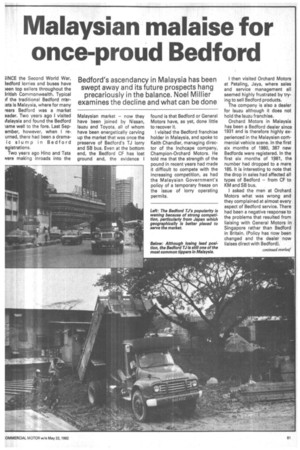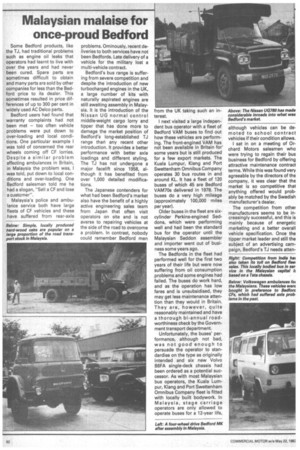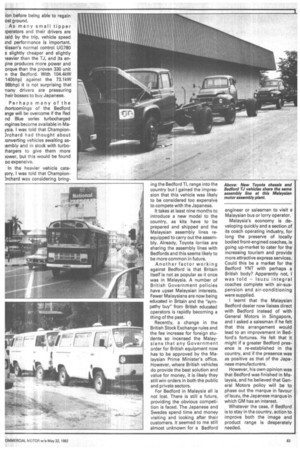Malaysian malaise for once-proud Bedford
Page 73

Page 74

Page 75

If you've noticed an error in this article please click here to report it so we can fix it.
Bedford's ascendancy in Malaysia has been swept away and its future prospects hang precariously in the balance. Noel Millier examines the decline and what can be done
;INCE the Second World War, 3edford lorries and buses have )een top sellers throughout the 3ritish Commonwealth. Typical A the traditional Bedford m'artets is Malaysia, where for many rears Bedford was a market eader. Two years ago I visited VIalaysia and found the Bedford lame well to the fore. Last Sepember, however, when I reurned, there had been a dramaic slump in Bedford 'egistrations.
Two years ago Hino and Tata were making inroads into the
Malaysian market — now they have been joined by Nissan, lsuzu and Toyota, all of whom have been energetically carving up the market that was once the preserve of Bedford's -1-,1 lorry and SB bus. Even at the bottom end, the Bedford CF has lost ground and, the evidence I
found is that Bedford or General Motors have, as yet, done little to recover it.
I visited the Bedford franchise holder in Malaysia, and spoke to Keith Chandler, managing director of the Inchcape company, Champion-Orchard Motors. He told me that the strength of the pound in recent years had made it difficult to compete with the increasing competition, as had the Malaysian Government's policy of a temporary freeze on the issue of lorry operating permits. I then visited Orchard Motors at Peteling, Jaya, where sales and service management all seemed highly frustrated by trying to sell Bedford products.
The company is also a dealer for Isuzu although it does not hold the lsuzu franchise.
Orchard Motors in Malaysia has been a Bedford dealer since 1931 and is therefore highly experienced in the Malaysian commercial vehicle scene. In the first six months of 1980, 387 new Bedfords were registered. In the first six months of 1981, the number had dropped to a mere 185. It is interesting to note that the drop in sales had affected all types of Bedford — from CF to KM and SB bus.
I asked the men at Orchard Motors what was wrong and they complained at almost every aspect of Bedford service. There had been a negative response to the problems that resulted from liaising with General Motors in Singapore rather than Bedford in Britain. (Policy has now been changed and the dealer now liaises direct with Bedford). Some Bedford products, like the TJ, had traditional problems such as engine oil leaks that operators had learnt to live with over the years and had never been cured. Spare parts are sometimes difficult to obtain and many parts are sold by other companies for less than the Bedford price to its dealer. This sometimes resulted in price differences of up to 300 per cent in widely used AC Delco parts.
Bedford users had found that warranty complaints had not been met — too often vehicle problems were put down to over-loading and local conditions. One particular example I was told of concerned the rear wheels coming off CF lorries. Despite a similar problem affecting ambulances in Britain, in Malaysia the problem was, I was told, put down to local conditions and over-loading. One Bedford salesman told me he had a slogan, "Sell a CF and lose a customer".
Malaysia's police and ambulance service both have large fleets of CF vehicles and these have suffered from rear-axle problems. Ominously, recent deliveries to both services have not been Bedfords. Late delivery of a vehicle for the military lost a multi-vehicle contract.
Bedford's bus range is suffering from severe competition and despite the introduction of new turbocharged engines in the UK, a large number of kits with naturally aspirated engines are still awaiting assembly in Malaysia. It is the introduction of the Nissan UG normal control middle-weight cargo lorry and tipper that has done more to damage the market position of Bedford's long-established TJ range than any recent other introduction. It provides a better performance with better axle loadings and different styling. The TJ has not undergone a major facelift since 1958, although it has benefited from over 1,000 detailed modifications.
The Japanese contenders for what had been Bedford's market also have the benefit of a highly active engineering sales team from Japan that often visit operators on site and is not averse to repairing vehicles at the side of the road to overcome a problem. In contrast, nobody could remember Bedford men from the terest. UK taking such an in I next visited a large independent bus operator with a fleet of Bedford VAM buses to find out how these vehicles are performing. The front-engined VAM has not been available in Britain for some years but is still produced for a few export markets. The Kuala Lumpur, Kiang and Port Swettenham Omnibus Company operates 30 bus routes in and around KL. It has a fleet of 120 buses of which 45 are Bedford VAM70s delivered in 1978, The buses do a very high mileage {approximately 100,000 miles per year).
Older buses in the fleet are sixcylinder Perkins-engined Seddons, which were performing well and had been the standard bus for the operator until the Malaysian Seddon assembler and importer went out of business some years ago.
The Bedfords in the fleet had performed well for the first two years of their life but were now suffering from oil consumption problems and some engines had failed. The buses do work hard, and as the operation has low fares and is unsubsidised, they may get less maintenance attention than they would in Britain. They are, however, quite reasonably maintained and have a thorough bi-annual roadworthiness check by the Government transport department.
Unfortunately, the buses' performance, although not bad, was not good enough to persuade the operator to standardise on the type as originally intended and six new Volvo B6FA single-deck chassis had been ordered as a potential successor. As with most Malaysian bus operators, the Kuala Lumpur, Kiang and Port Swettenham Omnibus Company fleet is fitted with locally built bodywork. In Malaysia, stage carriage operators are only allowed to operate buses for a 12-year life, although vehicles can be demoted to school contract vehicles if their condition allows.
I sat in on a meeting of Orchard Motors salesmen who were trying to regain their bus business for Bedford by offering attractive maintenance contract terms. While this was found very agreeable by the directors of the company, it was clear that the market is so competitive that anything offered would prob ably be matched by the Swedish manufacturer's dealer.
The competition from other manufacturers seems to be increasingly successful, and this is mainly because of energetic marketing and a better overall vehicle specification. Once the tipper market leader and still the subject of an advertising campaign, Bedford's TJ needs atten ion before being able to regain ost ground.
As many small tipper )perators and their drivers are mid by the trip, vehicle speed Ind performance is important. gissan's normal control UG780 s slightly cheaper and slightly leavier than the TJ, and its en3ine produces more power and orque than the proven 330 unit n the Bedford. With 104.4kW 140bhp) against the 73.1kW 98bhp) it is not surprising that nany drivers are pressuring heir bosses to buy Japanese.
Perhaps many of the hortcomings of the Bedford ange will be overcome if the Red nd Blue series turbocharged ngines become available in Maysia. I was told that Champion)rchard had thought about :onverting vehicles awaiting asmmbly and in stock with turbo:hargers to give them more )ower, but this would be found oo expensive.
In the heavier vehicle cate;cry, I was told that Champion)rchard was considering bring ing the Bedford TL range into the country but I gained the impression that this vehicle was likely to be considered too expensive to compete with the Japanese.
It takes at least nine months to introduce a new model to the country, as kits have to be prepared and shipped and the Malaysian assembly lines reequipped to carry out the assembly. Already. Toyota lorries are sharing the assembly lines with Bedfords and this seems likely to be more common in future.
Another factor working against Bedford is that Britain itself is not as popular as it once was in Malaysia. A number of British Government policies have upset Malaysian interests. Fewer Malaysians are now being educated in Britain and the "sympathy buy" from British educated operators is rapidly becoming a thing of the past.
Recently, a change in the British Stock Exchange rules and the fee increase for foreign students so incensed the Malaysians that any Government order for British equipment now has to be approved by the Malaysian Prime Minister's office. However, where British vehicles do provide the best solution and value for money, it is likely they still win orders in both the public and private sectors.
For Bedford in Malaysia all is not lost. There is still a future, providing the obvious competition is faced. The Japanese and Swedes spend time and money visiting and looking after their customers. It seemed to me still almost unknown for a Bedford engineer or salesman to visit a Malaysian bus or lorry operator.
Malaysia's economy is developing quickly and a section of its coach operating industry, for long the preserve of locally bodied front-engined coaches, is going up-market to cater for the increasing tourism and provide more attractive express services. Could this be a market for the Bedford YNT with perhaps a British body? Apparently not, I was told — Isuzu integral coaches complete with air-suspension and air-conditioning were supplied.
I learnt that the Malaysian Bedford dealer now liaises direct with Bedford instead of with General Motors in Singapore, and I asked a salesman if he felt that this arrangement would lead to an improvement in Bedford's fortunes. He felt that it might if a greater Bedford presence is re-established in the country, and if the presence was as ,positive as that of the Japanese manufacturers.
However, his own opinion was that Bedford was finished in Malaysia, and he believed that General Motors policy will be to phase out the marque in favour of twat, the Japanese marque in which GM has an interest.
Whatever the case, if Bedford is to stay in the country, action to improve both the image and product range is desperately needed.






























































































